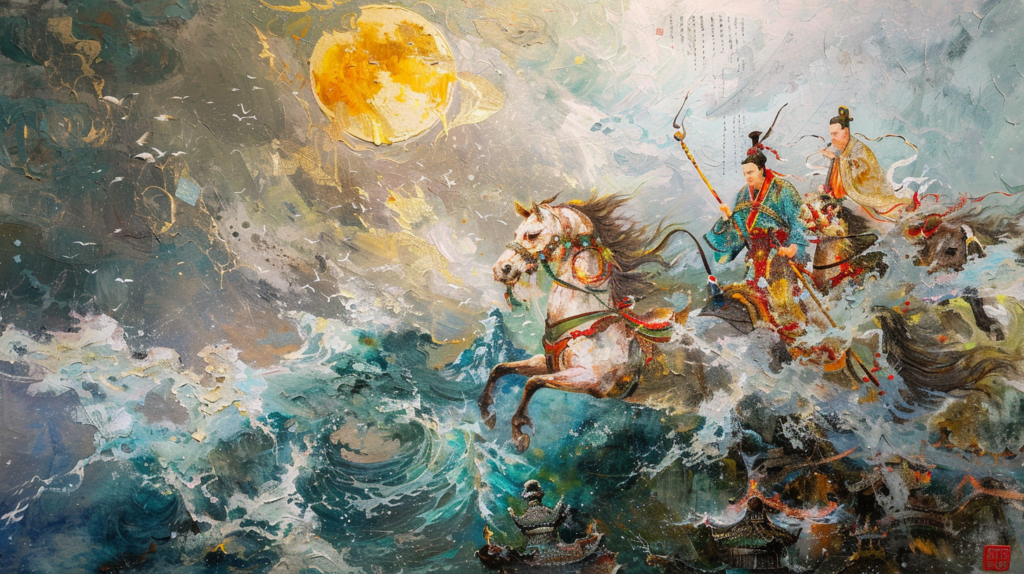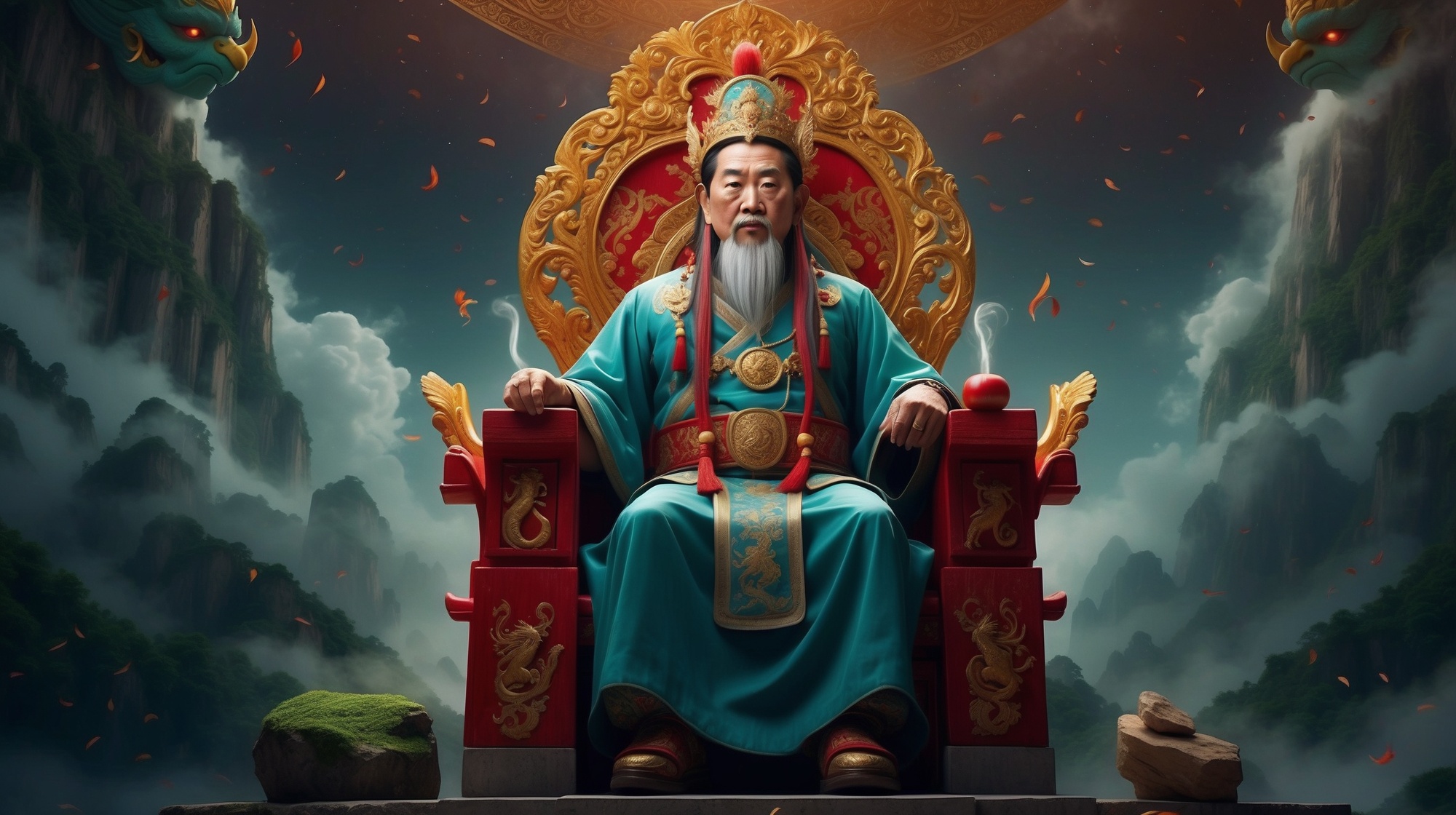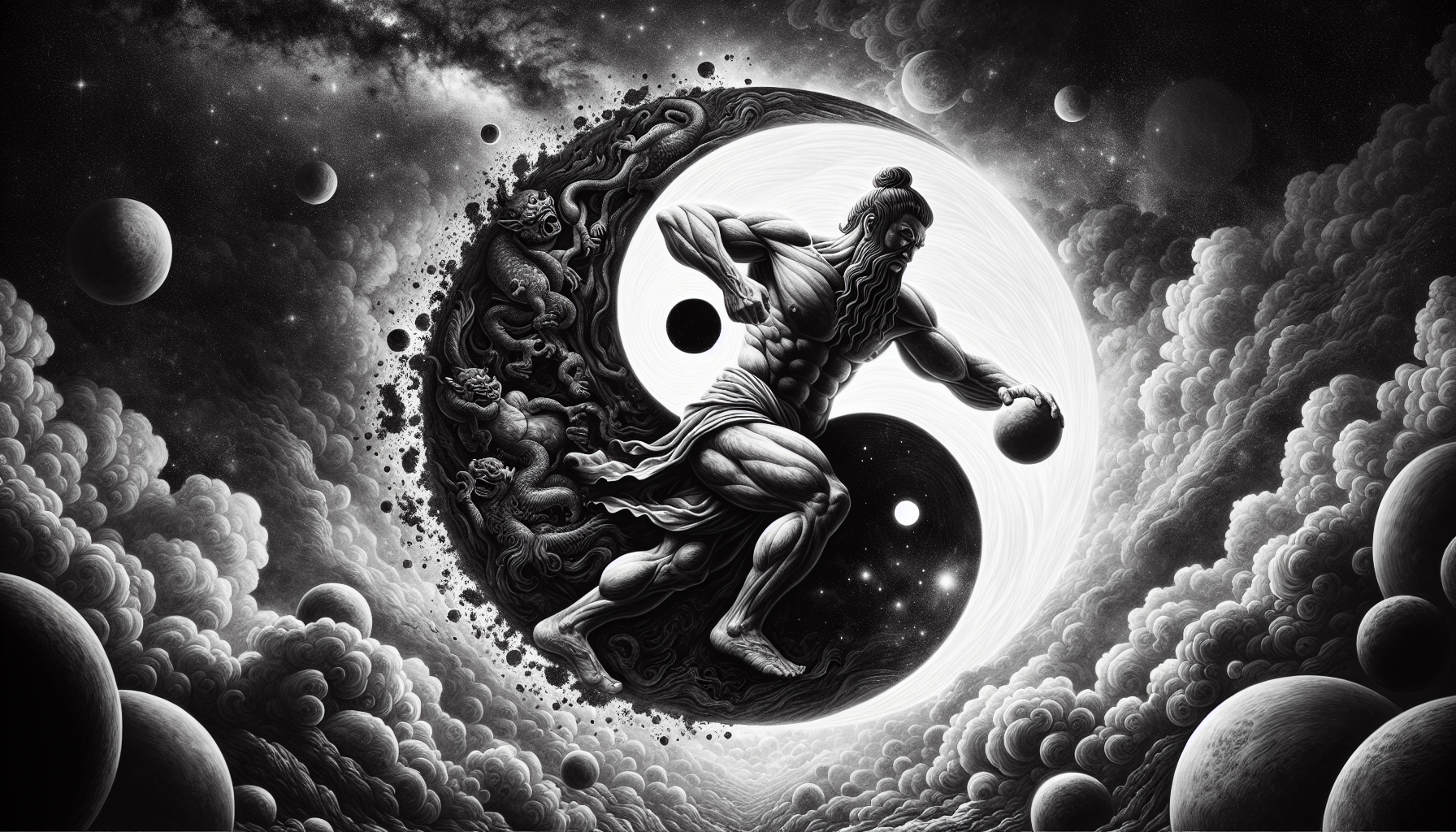AI-generated article summary
Journey to the West (西游记, Xīyóu Jì), stands as an iconic pillar within Chinese literature. Renowned across East Asia, this masterpiece narrates the captivating saga of the Buddhist monk, Tang Sanzang (唐三藏), accompanied by his three unique disciples: the audacious monkey king Sun Wukong (孙悟空), the jovial pig spirit Zhu Bajie (猪八戒), and the steadfast sand demon Sha Wujing (沙悟净). Together, they embarked on a perilous journey to India, driven by the noble quest to retrieve sacred scriptures. Their path is fraught with many trials, adversaries, and mystical beings, making their adventure not just exhilarating but profoundly symbolic.
This literature does more than entertain. Journey to the West delves deep into the essence of religion, morality, friendship, and the human condition. It is a satire of the Chinese society and bureaucracy, offering a spiritual odyssey and an allegorical quest for enlightenment. Packed with cultural, historical, and folkloric gems, it reflects the boundless creativity of its author.
This article aims to unfold the enthralling story of Journey to the West, guiding its inception, authorship, narrative, characters, symbolism, impact, and adaptations. Whether you’re a connoisseur or a newcomer eager to explore, join us on this remarkable exploration.
Origins and Authorship
Journey to the West is a masterpiece that seamlessly blends a rich tapestry of literary and cultural traditions, drawing from various sources, including folk tales, legends, myths, historical narratives, religious scriptures, and earlier fictional works. The primary inspiration behind this enchanting novel is the real-life pilgrimage of the Buddhist monk Xuanzang (602–664) to India in the 7th century, on a quest for sacred texts. Xuanzang’s detailed chronicles, titled Great Tang Records on the Western Regions, lay the groundwork for the storyline and introduce some of the characters.
The narrative is greatly enriched by the addition of fantastical elements from folklore and the author’s own creative flair, showcasing the extraordinary powers and unique personalities of the monk’s disciples – the formidable monkey king Sun Wukong, the pig spirit Zhu Bajie, and the sand demon Sha Wujing – along with their thrilling encounters with a host of gods, demons, and mythological beings. The novel also interweaves elements from other literary creations, such as the poetic novelette The Story of How Tripitaka of the Great Tang Procures the Scriptures, composed by an anonymous writer in the 13th century, and the six-part drama The Journey of the Monk Tripitaka of the Great Tang Dynasty, authored by Yang Jingxian in the 16th century.
Journey to the West was created during the Ming dynasty (1368-1644), a period marked by political stability, economic prosperity, and a flourishing of the arts. The novel reflects the cultural, social, and religious landscape of the time, including the popularity of vernacular literature, the influence of Buddhism, and the examination system that shaped Chinese society. It also mirrors the influence of Chinese folk religion, Chinese mythology, Confucianism, and Taoism, effectively capturing the beliefs, traditions, and ethics of the Chinese populace.
The question of who wrote Journey to the West remains open to debate, given the absence of definitive evidence. Initially written and published anonymously in the 1590s, the novel has been largely attributed to Wu Cheng’en (1506?–1582?), a renowned novelist and poet from the Ming period, since the 20th century. However, this attribution is not without its challengers, with some scholars proposing alternative authors such as Xu Zhonglin, Luo Guanzhong, or even suggesting the possibility of multiple anonymous contributors. It is plausible that Journey to the West is the culmination of a prolonged evolution of storytelling, undergoing countless revisions and embellishments by a series of authors and editors across several centuries.
Structure and Narrative Flow
Journey to the West, a 100-chapter novel divided into four volumes, is structured in a way that symbolizes completeness and perfection, reflecting the characters’ spiritual transformation. The novel can be divided into three main sections:
The first seven chapters introduce the Monkey King, Sun Wukong, and his acquisition of magical powers.
The next five chapters focus on Xuanzang (Tripitaka) and the divine origins of his pilgrimage to India to retrieve sacred Buddhist sutras.
The remaining 88 chapters recount the 81 adventures of Xuanzang and his three disciples – Sun Wukong, Zhu Bajie (Pigsy), and Sha Wujing (Sandy) – as they journey to India, facing numerous challenges and demons along the way.
The final chapters depict the pilgrims’ attainment of the sacred scrolls, marking the successful completion of their mission and symbolizing their personal growth and enlightenment. The novel’s structure enhances the narrative’s epic nature and highlights the characters’ transformative journey.

The Heart of the Saga: A Synopsis
Journey to the West is an epic novel that charts the remarkable adventures of Tang Sanzang, a devout Buddhist monk. He embarks on a perilous voyage from China to India with a mission to retrieve the sacred Buddhist scriptures. Alongside him are three exceptional disciples: Sun Wukong, the tempestuous yet potent Monkey King; Zhu Bajie, the hedonistic pig spirit with a penchant for indulgences; and Sha Wujing, the steadfast and silent sand demon. Their journey is fraught with daunting challenges and formidable adversaries, all in the quest for enlightenment.

Pilgrimage for Enlightenment
The tale unfolds with Sun Wukong’s birth, a being who masters supernatural powers and crowns himself the “Great Sage Equal to Heaven”. His havoc in the heavens earns him imprisonment by the Buddha beneath a mountain. Concurrently, Tang Sanzang, a young and virtuous monk, is chosen by the Bodhisattva Guanyin for an epic journey West. Equipped with a magical headband to ensure Sun Wukong’s obedience, Tang Sanzang embarks on his quest, during which he liberates Sun Wukong and gathers his other companions, Zhu Bajie and Sha Wujing. Additionally, he acquires a white dragon horse, revealed to be the transformed third son of the Dragon King of the West Sea, to serve as his loyal steed.
Encounters with Demons and Deities
Composed of 100 chapters, the novel weaves through diverse and thrilling episodes encountered by the pilgrims. They face many demons, monsters, and spirits, all coveting Tang Sanzang’s flesh, believed to bestow immortality. Encounters also bless their journey with friendly deities, sages, and hermits who aid or evaluate their virtues and faith. Memorable moments include battles with the Bull Demon King, rescuing Princess Iron Fan, the daunting Flaming Mountains, skirmishes with the formidable Red Boy, defeating the Spider Women, an intriguing visit to the Women’s Kingdom, confronting the White Bone Demon, and the significant arrival at the Thunder Monastery.
Enchanting Characters and Their Symbolism

Journey to the West is a beloved novel brimming with a cast of enchanting characters, each bringing their own unique personality, backstory, and purpose to the narrative. These main characters aren’t just entertaining and unforgettable; they’re also deeply symbolic. They embody various facets of human nature, reflecting the diverse stages and obstacles encountered in a spiritual odyssey. By delving into their traits and actions, we unlock a richer comprehension of the novel’s underlying themes and messages.
Sun Wukong/Monkey King: Rebellion and Redemption
Sun Wukong, better known as the Monkey King, is the novel’s most celebrated and iconic figure. This extraordinary monkey, born from a stone egg, attains remarkable powers through sheer determination and curiosity. He frequently defies the celestial realm’s authority because of his rebelliousness, wit, arrogance, and fearlessness. Despite this, he’s also depicted as loyal, courageous, clever, and astute, consistently safeguarding his master and peers from various perils. As the group’s leader and guardian, his dynamic prowess shines through.
Symbolizing the mind and the yang principle—the active and creative force in nature—Sun Wukong’s name translates to “awakened to emptiness,” mirroring his enlightenment on the truth of existence. He epitomizes the dual themes of rebellion and redemption, evolving from a disruptor to a Bodhisattva, a being dedicated to the enlightenment of all. His journey offers a metaphor for the cultivation of wisdom and compassion, as well as the transcendence of ego and attachment.
Tang Sanzang/Tripitaka: The Embodiment of Faith and Purity
Tang Sanzang, also known as Tripitaka, is the tale’s protagonist and heart. Selected by the Bodhisattva Guanyin for the treacherous mission to acquire Buddhist sacred texts from the West, his character is the embodiment of humility, compassion, and devotion. Adhering strictly to his faith’s principles, he nevertheless often finds himself the target of demons and monsters, due to his naive and gentle nature. He embodies the roles of master and teacher, albeit as the most vulnerable member of the expedition.
Tang Sanzang represents the heart and the yin principle—the passive and receptive force. His name, meaning “three baskets,” alludes to the Buddhist canon’s tripartite division. He personifies the ideals of faith and purity, persevering against all manner of trials and tribulations. His quest symbolizes the pursuit of merit and virtue, along with the purification of karma and defilements.
Zhu Bajie/Pigsy and Sha Wujing/Sandy: Human Flaws and Spiritual Growth
Zhu Bajie, or Pigsy, and Sha Wujing, known as Sandy, serve as Tang Sanzang’s other two disciples. Once celestial beings, they were relegated to the mortal world due to their transgressions. Zhu Bajie, a pig spirit formerly known as the Marshal of the Heavenly Canopy, faced expulsion for his lustful conduct. He embodies human-like flaws, such as greed, laziness, gluttony, and lechery. Yet, he also displays strength, bravery, humor, and helpfulness, engaging in battle with his distinctive rake and keen sense of smell.
Zhu Bajie symbolizes the body and the human tendency to seek pleasure through the senses. His name, translating to “eight precepts,” refers to the foundational ethical guidelines for lay Buddhists. He illustrates the struggle for spiritual growth, striving to conquer his weaknesses and vices. His path serves as a metaphor for temperance and promoting generosity and morality.
Sha Wujing, a once-proud Curtain-Lifting General demoted for his indiscretion, is a quiet, loyal, and hardworking sand demon. Despite his former life as a violent entity preying on travelers, as Tang Sanzang’s disciple, he transforms into a stalwart protector. This transformation makes him a figure of potential redemption and spiritual awakening.
Symbolizing the spirit, Sha Wujing’s name—meaning “awakened to purity”—highlights his commitment to purifying his mind and soul. He represents the human capacity for profound change, moving from a malevolent being to a guardian. His narrative underscores the journey toward the enlightenment of wisdom and the emancipation from suffering and ignorance.
Literary Legacy and Adaptations
Journey to the West is not just a story; it’s a cultural phenomenon transcending time and geography. This masterpiece has been translated into numerous foreign languages press. It has sparked many adaptations across the world and a wide range of art forms, including theater, film, television, manga, animation, video games, and music.
The novel is written in vernacular Chinese, making it accessible to a wide audience. It employs a mix of prose and poetry, with each chapter beginning with a poem that summarizes the events to follow. The author also uses various linguistic devices, such as puns, wordplay, and allusions to other works, adding depth and humor to the narrative.
Global Reach and Notable Translations
The journey of Journey to the West began internationally in the late 18th century with its first translation into French by Jesuit missionary Jean-Joseph-Marie Amiot. Since then, its stories have been embraced globally and translated into languages such as English, German, Russian, Japanese, Korean, Vietnamese, Thai, and Arabic. Noteworthy translations include:
Arthur Waley’s pioneering complete English translation, Monkey: A Folk Tale of China, was delivered in four volumes from 1942 to 1958.
An extensively annotated English version by Anthony C. Yu, published in four volumes between 1977 and 1983, named The Journey to the West.
A comprehensive and abridged English rendition by W.J.F. Jenner, published in 1982, also titled Journey to the West.
The modernized English translation by Julia Lovell, released in 2012, under the label Monkey King: Journey to the West.
Adaptations Across Media
The novel’s journey continues through various media, including stage plays, films, TV series, manga, animations, video games, and music, demonstrating its broad appeal. Some of the most celebrated adaptations are:
The Monkey King, a 1986 TV series by CCTV, with Liu Xiao Ling Tong portraying Sun Wukong. This adaptation is celebrated for its fidelity to the novel and stands as a classic representation.
Monkey, a 1978-1980 Japanese TV series based on Arthur Waley’s translation, featuring Masaaki Sakai as Sun Wukong. Loved for its catchy theme song and humor.
Dragon Ball, a manga and anime series running from 1984 to 1995, created by Akira Toriyama and inspired by the novel. It chronicles the adventures of Son Goku, a boy with a monkey tail, drawing inspiration from Sun Wukong.
A 2007 stage musical, Monkey: Journey to the West, created by the trio of Chen Shi-Zheng, Damon Albarn, and Jamie Hewlett, marrying traditional Chinese opera with circus elements and pop music.
A Chinese Odyssey, a two-part film from 1995 directed by Stephen Chow, casting himself as Sun Wukong. This version mixes comedy and fantasy, adding elements of time travel and romance.
The 2001 Disney animated series ‘The Legend of Tarzan,’ which features a character named Sun Wukong, a monkey who assists Tarzan in his adventures, showcasing the influence of Journey to the West on Western media.
The 2017 Chinese film ‘Wu Kong,’ starring Eddie Peng as Sun Wukong, offering a modern reimagining of the classic tale with stunning visual effects and action sequences.
The 2018 video game ‘Monkey King: Hero Is Back,’ an action-adventure game that allows players to control Sun Wukong and experience the journey firsthand, demonstrating the interactive potential of the story.
Journey to the West is a cornerstone of Chinese literature, alongside other classic novels such as Romance of the Three Kingdoms, Water Margin, and Dream of the Red Chamber. While each novel has its unique style and themes, they all offer insights into Chinese history, culture, and values and continue to captivate readers worldwide.
Conclusion
Journey to the West is undeniably a s that everyone who cherishes literature, culture, and adventure should immerse themselves in. This masterpiece of Chinese literature isn’t just a local treasure but a global phenomenon, leaving a lasting impact on countless readers and creators across generations. This captivating stories weaves the adventures of a Buddhist monk and his three disciples on their quest from China to India to retrieve sacred Buddhist scriptures.
It delves deeply into themes such as religion, morality, loyalty, history, friendship, and the essence of human nature, enriching its narrative beyond a simple journey. The characters’ struggles and triumphs reflect the Buddhist concepts of karma, reincarnation, and the Four Noble Truths. The novel also incorporates elements of Taoism and Confucianism, highlighting the complex interplay of religious and philosophical ideas in Chinese culture.
The novel is written with a spectrum of enchanting characters, each bringing their unique personality, backstory, and significance to the story, making it an exploration that goes beyond its words. Its ability to transcend cultural and historical limits has established it as a universal and timeless piece of art.
If Journey to the West has piqued your interest, many translations and adaptations are available in numerous languages and formats. Moreover, by exploring further, you can enrich your understanding of the novel’s background, authorship, plot, characters, symbolic meanings, legacy, and various adaptations. It’s our hope that this synopsis has sparked your curiosity, inviting you to experience the magical saga of Journey to the West firsthand.
FAQ
What is the story behind Journey to the West?
The story behind Journey to the West is a fictionalized account of the 7th-century pilgrimage of the Buddhist monk Xuanzang from China to India, aimed at acquiring sacred texts. Accompanied by three disciples, they encounter and overcome a series of obstacles and dangers along their path.
What is Journey to the West an allegory for?
Journey to the West serves as an allegory for the quest for enlightenment, reflecting Buddhist teachings. Additionally, it cleverly satirizes the societal norms and bureaucracy prevalent during the Ming dynasty in China.
Is Dragon Ball based on Journey to the West?
Indeed, Dragon Ball draws inspiration from Journey to the West, a renowned 16th-century Chinese novel. The character Son Goku mirrors Sun Wukong, the Monkey King, showcasing similar abilities and traits.
What reading level is Journey to the West?
The complexity of Journey to the West varies by edition. The original classic from the 16th century requires a reader to be familiar with at least 2500 Chinese characters, categorizing it as advanced. For Mandarin learners, however, there are simplified and abridged versions like the Pleco graded reader, recommended for HSK level 5, and new edition ofthe Oxford graded reader, suitable for CEFR A2 — making it more accessible and enjoyable.



